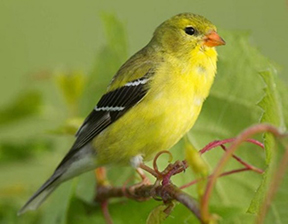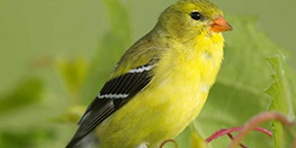JEFFERSON CITY, Mo. — Calling Missouri birders who know their birds by sight and sound!
The Missouri Department of Conservation (MDC) needs volunteers to assist with four vacant bird-observation routes in Missouri as part of the 2022 North American Breeding Bird Survey (BBS) May 27 – July 7. The four Missouri BBS routes that need volunteers are Auburn in Lincoln County, Cassville in Barry County, Kennett in Dunklin County, and Rueter in Taney County.

In breeding plumage, the upperparts of the female American goldfinch are greenish yellow with dark wings and tail. The underparts are pale yellow. It is one species volunteers may see and hear during the annual North American Breeding Bird Survey.
Volunteers will need to conduct their survey one day during the May 27 – July 7 survey period.
BBS is a long-term, large-scale, international bird monitoring program that started in 1966. The purpose of the BBS is to track the status and trends of North American bird populations. Each year during mostly June — the height of the bird-breeding season for most of the U.S. – BBS volunteers collect bird-population data along roadside survey routes to help. For more info on the BBS, visit pwrc.usgs.gov/bbs/.
Each survey route is 24.5 miles long with stops at half-mile intervals. At each stop, volunteers conduct three-minute point counts where they record data on the bird species and numbers they see or hear within a quarter-mile radius. Surveys must start one-half hour before sunrise and take about five hours to complete. Volunteers need only conduct their survey route once during the survey period.
For more information or to volunteer, contact MDC Resource Scientist and MDC BBS Coordinator Janet Haslerig by email at Janet.Haslerig@mdc.mo.gov or call 573-522-4115, ext. 3198.
Haslerig said volunteers need access to suitable transportation, must have good hearing and eyesight, and must be able to identify all birds in the area. All new BBS volunteers must successfully complete an online methodology training program before their data can be used.
She also stressed that knowing bird songs is extremely important. “Most birds counted on these surveys are singing males,” said Haslerig.
The annual BBS helps scientists determine bird populations and their threats.
“Bird populations have numerous, widespread threats including habitat loss, habitat fragmentation, land-use changes, and chemical contaminants,” said Haslerig. “The annual BBS is vital in determining how bird species are doing. For example, a recent article in the journal Science showed the loss of almost 3 billion birds in North America since 1970. These results were partially determined by long-term BBS data. This shows the necessity of these surveys and recruiting volunteers to conduct them over the long term.”
Haslerig hopes surveyors will commit to multiple years of collecting data on the same route. “It helps with the consistency in data collection,” she said. “And volunteers also get familiar with the routes and have better ideas what birds they will encounter. And it’s fun!”
For more information on birds of Missouri, visit the MDC online Field Guide at nature.mdc.mo.gov/discover-nature/field-guide/search.

